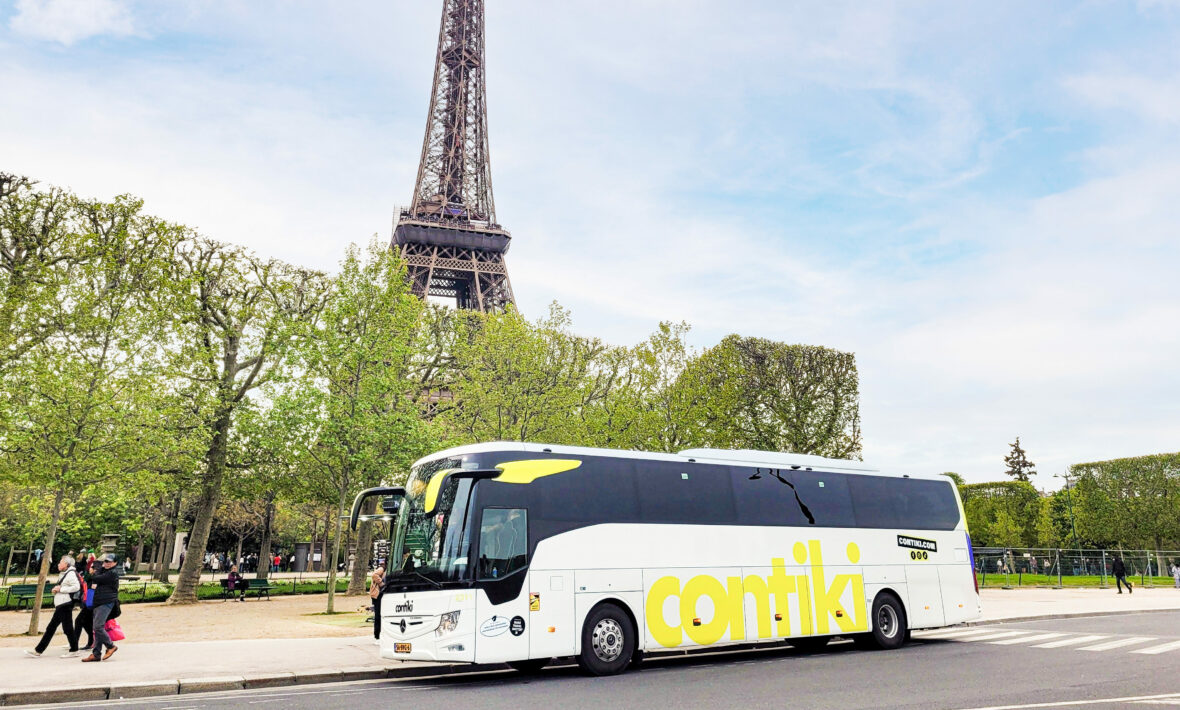
In 2022 Contiki went carbon neutral, and that made us so proud! But it also wasn’t enough – so now we’re on the road to Net Zero (confused about the difference? You can read about it the comparison between carbon neutral and net zero here). As part of our climate action plan, we have tackled one of the biggest parts of our amazing trips in Europe: the coaches. We love our Contiki coaches, so much so that we’ve named them, and they’re what enable us to take so many of you across the globe! So they’ve had a little bit of a makeover on the inside, because that’s what counts.
As of January 2024 our Contiki coaches across Europe are using a new kind of biofuel! What kind of biofuel? What does it do? Well, we’ve interviewed Tasha Hayes, Contiki’s Global Sustainability Officer, and Gerco Don, the managing director of Atlas Reizen (our coach provider), to get all the details about this new juice and why this is such a huge step forward.
Hi Tasha and Gerco, could you please explain what biofuel is?
“So, there’s lots of different types of biofuel,” says Gerco, “but we use hydrotreated vegetable oil (HVO), and again there are different types of that. There’s HVO20 and HVO50 for example, and the number is equivalent to the percentage of HVO that’s mixed in with diesel. We use HVO100.”
“HVO is a kind of diesel, but it’s not a fossil-based diesel, it’s made from waste. It can be made with food waste and plant waste. This can sound like it would contribute to more harm, like deforestation, but that’s not the case: the HVO that we use is purely made using existing food and plant waste, so nothing is purposely grown to be used as waste.”

Image source:Contiki
What are the advantages of using biofuel?
“The biggest advantage to using biofuels, specifically HVO, is the reduction of CO2 emissions. Even though our coaches already do what they can to reduce carbon emissions, the new use of HVO is a massive leap in progress as the official figures state that HVO produces 90% less carbon than other fuels.”
Will the coaches still run the same?
Gerco ensures that even with the switch to HVO our coaches will run “exactly the same. HVO can be mixed with diesel, so even if we run out on the road the tank can be filled up. But HVO is becoming more widely available throughout Europe as we speak, so we will be able to use it on the road more and more.”
“Performance-wise, the vehicle isn’t affected at all. It’s not slower or anything like that, it’s only reducing CO2.”
When did the use of biofuel first start to roll out?
“We started this from the 1st of January 2024,” explains Tasha. “So it’s still a work in progress. The proposal for the change was put together by Gerco and I last year, and after doing all the planning, research, calculations, etc. we decided to start it this year.”
“So far the use is limited to our European operations, and only on our Atlas Reizen provided coaches – trips that use non-Contiki coaches, like very regional and remote ones, are an exception to the rule just because we can’t control those. But right now we have biofuel in use on the majority of our European trips, and we’re hoping to continue to use as much as we can get our hands on.”

Was this change hard to implement?
“It had no impact on the coaches, so it wasn’t difficult there, but what we are doing is figuring out some details on the road,” says Gerco. “Our routes on trip are pretty set, and a lot of them are dictated by re-fueling stops and price, but not all of our currently used stops offer HVO. What we’re trying to figure out is alternate routes that won’t disrupt the trip and driving length too much, while also allowing our drivers to refuel with HVO as much as possible.”
“Currently 38% of our routes allow for HVO and the aim this year is to get to 50%. Luckily, more countries are coming around to it. For example, when we first put this proposal together Italy was tricky because they had no HVO, but since we’ve started this initiative, HVO has become available in Italy. It’s an evolving process.”
Is the use of HVO biofuel a permanent solution for Contiki?
“The idea of our sustainability plan is, of course, to reduce our emissions as much as possible,” says Tasha. “Electric coaches exist, but with the distances that we cover on Contiki they’re just not a very viable option at the moment. So this is our interim solution. It’s not forever, but this is what will make the largest impact in slashing our emissions in Europe overall.”
And Gerco fully agrees: “Our coaches are already so much better than other modes of transport like planes and boats, and we have a 53 person capacity which makes them much more efficient than cars. So already Contiki has low emissions relative to the industry, and this will help progress that even more.”
As of December 2024, our aim to reduce carbon emissions has made tremendous strides! Our initial goal was to reduce emissions by 30-40%, but we exceeded these numbers by reducing emissions by 57.7%! We have added 10 additional HVO fuel points in Europe to our itineraries to ensure that our trips can continue to reduce emissions as we go.







